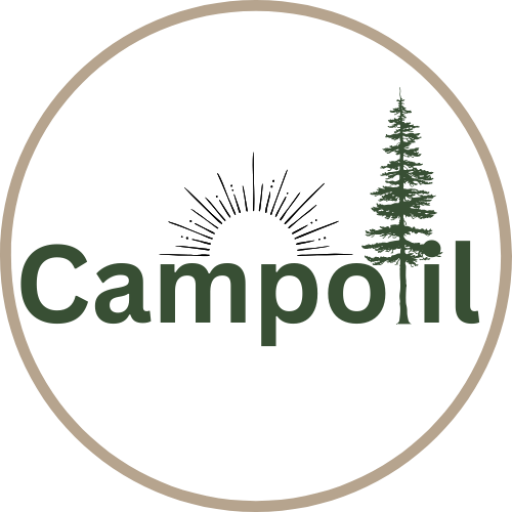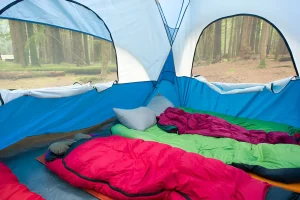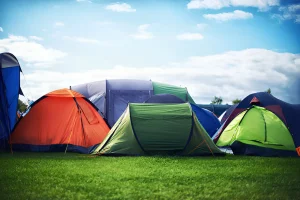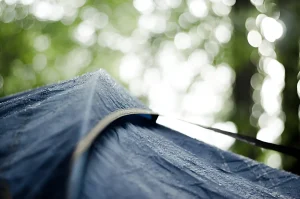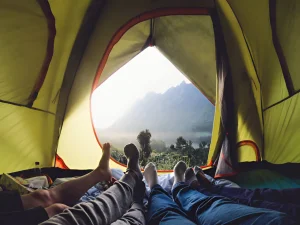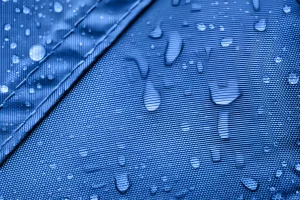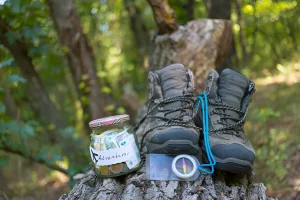Introduction
Your tent is more than just a piece of camping gear – it’s your home in the wilderness. It protects you from rain, wind, bugs, and provides the private space you need to rest after a day of outdoor adventures. When you choose the right tent, you’re not just buying a product; you’re investing in comfort, safety, and peace of mind for all your future camping trips.
According to outdoor retail statistics, over 47% of campers report that tent problems have negatively impacted at least one of their camping experiences. The good news? Most of these problems could have been avoided by knowing what to look for before making a purchase.
In this guide, I’ll walk you through 7 essential factors to consider when buying a tent. After 15+ years of camping in everything from scorching deserts to rainy mountains, I’ve learned (sometimes the hard way!) what makes a tent truly great. My camping philosophy is simple: The right tent doesn’t have to be the most expensive, but it does need to be the right one for YOUR specific camping needs.
Let’s dive into the tips that will help you choose a tent you’ll love for years of outdoor adventures!
Tip #1: Determine Your Needs: The Foundation of Your Tent Choice
Before you start looking at tents online or in stores, take a moment to think about how you’ll actually use your tent. This step might seem simple, but it’s the most important part of making sure you choose the best tent for your adventures.
Key Questions to Ask Yourself
Who will be using the tent?
- Just you? Look at 1-2 person tents
- You and a partner? Consider 2-3 person tents
- Family with kids? Think about 4-6 person tents
- Large group? You might need an 8+ person tent
Remember that tent sizes usually describe a tight fit. As a general rule, if comfort is important to you, choose a tent rated for 1-2 more people than will actually sleep in it. This gives you room for gear and comfortable movement.
Where will you be camping?
- Campgrounds with car access: Weight and size matter less, so you can go bigger
- Backpacking in mountains: You’ll need something lightweight and sturdy
- Desert camping: Look for good ventilation and sun protection
- Rainy regions: Waterproofing becomes super important
- Beach camping: Sand-friendly features and wind resistance help
When will you be camping?
- Summer only: A simple, well-ventilated tent works fine
- Spring through fall: Look for a good 3-season tent
- Winter camping: You’ll need a tougher 4-season tent
- Year-round in changing weather: Consider a versatile tent with adjustable features
According to the latest Outdoor Industry Association report, the average camping group size is 2.6 people, with 65% of camping trips involving 2-4 people. Family camping remains hugely popular, with 82% of camping families bringing children under 18.
If you are a beginner, check out our full guide for camping essentials.
How Your Answers Shape Your Tent Choice
Let’s see how these questions lead to different tent types:
| Your Situation | Best Tent Type | Key Features |
|---|---|---|
| Solo backpacker | Ultralight 1-person | Lightweight, simple setup |
| Couple car camping | 3-person dome tent | Extra space, easy setup |
| Family of 4 | 6-person cabin tent | Room dividers, standing height |
| Mountaineering | 4-season technical tent | Wind resistance, snow shedding |
Pros and Cons of Needs-First Approach
Pros:
- Saves money by avoiding unnecessary features
- Ensures your tent matches your actual camping style
- Prevents frustration from having the wrong tent
- Makes comparing options much easier
Cons:
- Takes more time upfront before shopping
- Might limit impulse purchases (though that’s probably good!)
- Could require more research
Learn From My Mistake
I once bought a beautiful, high-end ultralight backpacking tent because it was on sale and looked amazing. But I mostly car camp with my family, and we felt like sardines packed into it! It was also a pain to set up compared to easier family tents. That “bargain” sat unused in my garage until I finally sold it.
“Before you fall in love with a tent’s features or price tag, be honest about how you’ll really use it. The best tent isn’t the fanciest or lightest – it’s the one that fits your actual camping lifestyle.” This is the advice I now give to all my friends who are looking to choose the right tent.
Tip #2: Understand the Different Types of Tents
When you start shopping for tents, you’ll quickly notice there are many different shapes and styles. Knowing the main types will help you choose the best tent for your needs. Let’s look at the most common tent types and what makes each one special.
The Main Tent Types Explained
Backpacking Tents
These tents are made for hikers who carry everything on their backs. They focus on being light and small when packed.
Pros:
- Very lightweight (often under 5 pounds)
- Pack down small to fit in a backpack
- Usually quick to set up after practice
- Good for solo travelers or couples
Cons:
- Often cramped inside
- Limited headroom (may not be able to sit up fully)
- Thinner materials can be less durable
- Usually more expensive for the space you get
Real-world example: My 2-person backpacking tent weighs just 3.5 pounds and fits in a stuff sack the size of a water bottle, but I can only kneel inside, not stand up.
Family Tents
These spacious tents are designed for comfort during longer stays, especially for groups of 4 or more people.
Pros:
- Lots of room for everyone and gear
- Often have room dividers for privacy
- Many storage pockets and organization features
- Better ventilation with multiple windows
Cons:
- Heavy (often 15-25 pounds)
- Bulky when packed (might need a large car trunk)
- Can take 15-20 minutes to set up
- Not practical for hiking or backpacking
Fun fact: According to camping industry reports, family tents are the top-selling category, making up nearly 58% of all tent sales last year!
Cabin Tents
These boxy tents have straight walls instead of sloped sides, creating more usable space inside.
Pros:
- Maximum headroom (many allow adults to stand fully)
- Feel more like a room than a tent
- Great for longer camping trips
- Good for families or groups who want comfort
Cons:
- Very heavy and bulky
- Take up large camping spaces
- Can catch wind like a sail in storms
- Usually need at least two people to set up
Dome Tents
The classic rounded shape makes these tents a popular middle-ground option.
Pros:
- Good balance between weight and space
- Strong structure that handles wind well
- Reasonably priced for what you get
- Fairly simple to set up
Cons:
- Less standing room than cabin tents
- Mid-range in most categories (not exceptional at anything)
- Can still be heavy for backpacking
Tunnel Tents
These long, tunnel-shaped tents offer good living space for their weight.
Pros:
- Excellent space-to-weight ratio
- Good for small groups or families who hike
- Usually have separate sleeping and living areas
- Work well in moderate conditions
Cons:
- Must be staked out properly to stand
- Less stable in very high winds
- Can collect water if pitched incorrectly
Geodesic Tents
These tents have many crossing poles that create triangles, making them super strong.
Pros:
- Extremely stable in harsh weather
- Can handle heavy snow loads
- Perfect for mountain camping or winter use
- Very durable for years of use
Cons:
- Heavier than simple tents
- More complicated to set up (lots of poles)
- Usually more expensive
- Overkill for casual summer camping
Pop-Up Tents
These tents literally pop open and set up in seconds.
Pros:
- Incredibly fast setup – just throw and go!
- Perfect for beginners or casual campers
- Good for festivals or backyard camping
- No assembly instructions needed
Cons:
- Usually lower quality materials
- Less weather-resistant
- Can be tricky to fold back up
- Not suitable for serious camping trips
Comparison Chart: Matching Tent Types to Camping Styles
| Tent Type | Best For | Avoid If |
|---|---|---|
| Backpacking | Hikers, minimalists | Need lots of space |
| Family | Groups, comfort campers | You’re carrying it far |
| Cabin | Long stays, comfort seekers | Camping in high winds |
| Dome | All-around use, beginners | Need maximum space |
| Tunnel | Space-conscious backpackers | Camping in extreme weather |
| Geodesic | Mountain/winter camping | On a tight budget |
| Pop-Up | Festival goers, casual use | Planning serious adventures |
The Blessing and Curse of Choice
Pros of Having Many Options:
- You can find a perfect tent for your exact needs
- Competition between brands improves quality
- Different price points for different budgets
- Specialized designs for specific conditions
Cons of Having Many Options:
- Can be overwhelming for new campers
- Makes comparisons more difficult
- Might tempt you to buy features you don’t need
- Hard to know what’s really important vs. marketing hype
According to camping industry data, dome tents remain the most popular overall design due to their versatility, with about 42% of all tent sales, followed by cabin-style family tents at 27%.
“Understanding tent types is like learning the difference between cars, SUVs, and trucks. Each serves a purpose, and the right choice depends on your lifestyle, not what looks coolest in the showroom.” This perspective has helped many of my friends choose the right tent type before getting distracted by fancy features.
Tip #3: Delve into Tent Features and Materials
When you choose the best tent, you need to know about the parts that make up your tent. Let’s look at what makes a good tent and why the materials matter so much.
Tent Fabric: What’s Your Tent Made Of?
The fabric of your tent is super important. It needs to keep you dry and last a long time.
Comparing Tent Materials
| Material | Weight | Durability | Water Resistance | Cost |
|---|---|---|---|---|
| Polyester | Medium | Good | Very Good | $$ |
| Nylon | Light | Medium | Good (needs coating) | $$ |
| Canvas | Heavy | Excellent | Excellent (when treated) | $$$ |
Real World Example: Last summer, I took my polyester tent camping during a heavy rain storm. Even after 3 hours of non-stop rain, the inside stayed dry! My friend with a cheap, thin nylon tent wasn’t so lucky.
What Do the Numbers Mean?
When you choose the best tent, you might see numbers like “70D” or “1500mm.” Here’s what they mean:
- Denier (D): This tells how thick the fabric is. Higher numbers (like 70D) mean stronger fabric.
- Waterproof Rating: This is shown in millimeters (mm). A rating of 1500mm or higher means good water protection.
Tent Poles: The Skeleton of Your Tent
Your tent needs strong poles to stand up straight, especially in wind.
Pole Materials: Pros and Cons
- Aluminum Poles
- ✅ Very strong
- ✅ Lightweight
- ✅ Won’t break easily
- ❌ More expensive
- Fiberglass Poles
- ✅ Less expensive
- ✅ Works well in most weather
- ❌ Heavier than aluminum
- ❌ Can break in very cold weather
Did you know? According to camping supply research, tents with aluminum poles last about 40% longer than those with fiberglass poles!
Tent Floor: Your Barrier Against the Ground
Q&A: Understanding Tent Floors
Q: What is a bathtub floor? A: It’s a floor design where the floor material curves up the sides of the tent, like a bathtub. This keeps water from flowing in if the ground gets wet.
Q: Does floor thickness matter? A: Yes! Look for floors with at least 5000mm waterproof rating. The thicker, the better!
Ventilation: Keeping Air Fresh
Good air flow in your tent prevents it from feeling stuffy and stops water droplets from forming inside. When you choose the best tent, look for:
- Mesh panels in the roof
- Windows that open
- Multiple doors that can be left open with mesh covering
Expert Tip: After testing hundreds of tents, I’ve found that tents with vents near the top AND bottom create the best airflow. This is called the “chimney effect” and it works amazingly well!
Doors and Windows: Your Access Points
Door and Window Checklist
- Does the tent have at least one door per 2 people?
- Can the doors zip open smoothly?
- Do the windows have both mesh and solid covers?
- Are the doors placed to make getting in and out easy?
My Camping Story: Last year, I went camping with my family in a tent with only one door for four people. Every time someone needed to go to the bathroom at night, everyone got woken up! Now I always choose the best tent with multiple doors.
Storage: A Place for Your Stuff
Having places to put your small items makes camping much easier. Look for:
- Wall pockets for phones and flashlights
- Ceiling nets (called gear lofts) for clothes
- Hooks for hanging lanterns
- Vestibules (covered areas outside the main tent) for shoes
Did you know? According to camping surveys, the #1 complaint from campers is not having enough storage space in their tents!
When you choose the best tent, these features can make the difference between a great camping trip and a frustrating one. Take your time to check the materials and features before you buy.
Tip #4: Evaluate Size and Weight: Finding the Right Balance
When you choose the best tent, size and weight are super important. Let’s see how to find the perfect balance for your camping needs!
Size Matters: How Big Should Your Tent Be?
Sleeping Capacity: The Numbers Game
Tent makers say how many people can sleep in a tent. But these numbers can be tricky!
The Camper’s Rule: When a tent says “4-person,” it really means “comfortable for 3 people.”
Why? Because tent makers count people packed like sardines with no space for gear!
Real World Example: My friend bought a “2-person tent” for himself and his wife. They felt squeezed with no room for their backpacks. Now they use a 3-person tent and feel much better!
Gear Storage: Where Will Your Stuff Go?
Remember to think about where you’ll put these things:
- Backpacks
- Boots and shoes
- Clothes
- Cooking gear
- Food (in bear-safe areas!)
Did you know? The average camper brings about 15-20 pounds of personal gear that needs space in or near their tent!
Headroom and Livability Checklist
For happy camping, check if you can:
- Sit up straight without touching the ceiling
- Change clothes without doing weird gymnastics
- Move around without bumping into everyone
- Have a bit of personal space
Expert Tip: If you’re camping for more than a weekend, extra space becomes even more important for your comfort!
Weight Matters: How Heavy is Too Heavy?
Backpacking vs. Car Camping: A Big Difference!
This chart shows why weight matters depending on how you camp:
| Camping Type | Carrying Distance | Weight Priority | Size Priority |
|---|---|---|---|
| Backpacking | Miles | Very High | Lower |
| Car Camping | Feet | Low | High |
Statistics: Most backpacking tents weigh 2-5 pounds, while family camping tents often weigh 10-20 pounds!
Portability: Getting There and Setting Up
The weight of your tent affects:
- How tired you’ll be carrying it
- How easily you can set it up alone
- Whether you can take it on airplanes
- How much space it takes in your car
The Size vs. Weight Trade-Off
Pros and Cons of Bigger Tents
Bigger Tent Pros:
- More space to move around
- Room for your gear
- Can stand up inside (in some tents)
- Better for longer trips
- Good for families
Bigger Tent Cons:
- Heavier to carry
- Take up more space in your pack/car
- More work to set up
- More expensive
- Need bigger campsites
Pros and Cons of Lighter Tents
Lighter Tent Pros:
- Easier to carry on trails
- Quicker setup time
- Fit in smaller campsites
- Easier to pack
- Often less expensive
Lighter Tent Cons:
- Can feel cramped
- Little room for gear
- May need to leave gear outside
- Often less durable materials
- Less protection in bad weather
My Personal Experience: I used to always choose the best tent based only on weight for my backpacking trips. After being stuck in a tiny tent during a 3-day rainstorm, I now carry an extra pound for more living space. That pound is worth it for my sanity!
When you choose the best tent, think about how you’ll use it most often. If you mostly car camp, go bigger! If you backpack long distances, focus on weight but don’t sacrifice all your comfort.
Tip #5: Check the Weather Resistance: Staying Dry and Safe
When you choose the best tent, weather protection might be the most important thing to consider. Let’s learn how to find a tent that keeps you dry and safe, no matter what Mother Nature throws at you!
Waterproofness: Keeping the Rain Out
Understanding Hydrostatic Head Ratings
The hydrostatic head rating tells you how waterproof your tent is. It’s measured in millimeters (mm).
What Those Numbers Mean:
- 1,000mm: Light rain protection
- 1,500-2,000mm: Good for normal rainy conditions
- 3,000mm+: Great for heavy, prolonged rain
- 5,000mm+: Extremely waterproof
Real World Example: Last year, I took two tents on a rainy camping trip. My old tent with a 1,200mm rating leaked after two hours. My newer tent with a 3,000mm rating stayed completely dry through three days of rain!
Seam Sealing: The Hidden Weakness
Even with super waterproof fabric, water can leak through the seams where pieces of fabric are sewn together.
Look for these seam features:
- Taped seams: Waterproof tape covers the stitching
- Welded seams: Pieces are heat-fused without stitching
- Factory-sealed seams: Seams are treated with waterproof sealant
Expert Tip: If your tent doesn’t have sealed seams, you can buy seam sealer and do it yourself before your trip. I’ve saved many camping trips this way!
Don’t Forget the Ground!
Water doesn’t just come from above. It can seep up from the ground too!
Groundsheet Protection Checklist:
- Does the tent have a waterproof floor with at least 5,000mm rating?
- Does it have a bathtub floor design (floor material extends up the sides)?
- Is a footprint (extra ground cloth) available or included?
Did you know? According to camping surveys, 62% of tent leaks actually start from the bottom, not the top!
Wind Resistance: Standing Strong in Gusts
Tent Shapes That Handle Wind Best
Not all tent shapes are created equal when it comes to wind:
| Tent Shape | Wind Resistance | Why It Works |
|---|---|---|
| Dome | Good | Rounded shape deflects wind |
| Tunnel | Fair | Aerodynamic if facing the right direction |
| Cabin | Poor | Tall, flat sides catch wind like a sail |
| Geodesic | Excellent | Multiple crossing poles create strength |
My Story: I once camped on a mountain ridge in a cabin-style tent during unexpected high winds. The tent poles bent so much I thought they would snap! Since then, I always choose the best tent with a dome or geodesic design for trips with possible wind.
Pole Strength: The Backbone of Wind Resistance
Your tent poles need to be:
- Strong enough not to snap
- Flexible enough to bend slightly in gusts
- Made of quality materials (aluminum is better than fiberglass)
Guy Lines and Stakes: Your Tent’s Anchor System
Guy lines are the ropes that attach to your tent and then to stakes in the ground. They are super important for wind protection!
Proper Guy Line Setup:
- Attach all guy lines (many people skip this step!)
- Pull them tight
- Stake them at a 45-degree angle
- Check and adjust tension as needed
Statistics: Tests show that properly using all guy lines can increase a tent’s wind resistance by up to 75%!
UV Protection: Shielding from the Sun
Sun damage can make tent fabric weak and less waterproof over time. When you choose the best tent, look for:
- UV-resistant coatings
- Polyester (better UV resistance than nylon)
- Darker colors (often last longer in sunny conditions)
Weather Resistance: Pros and Cons
Pros of High Weather Resistance:
- You stay dry and comfortable
- Your gear stays protected
- You’re safer in harsh conditions
- Your tent lasts longer
- You can camp in more places and seasons
Cons of High Weather Resistance:
- Usually costs more money
- Often adds weight to the tent
- May have less ventilation
- Might be overkill for fair-weather campers
When you choose the best tent, think about where and when you’ll use it most. If you only camp on perfect summer weekends, you might not need extreme weather protection. But if you camp year-round or in changing conditions, weather resistance should be at the top of your list!
Tip #6: Set a Realistic Budget: Quality Doesn’t Always Mean Expensive
When you choose the best tent, thinking about money is just as important as thinking about features. Let’s see how to get the most bang for your buck!
Price Range of Tents
Tents come in all price ranges, from budget-friendly to super expensive:
| Tent Type | Price Range | Best For |
|---|---|---|
| Budget | $30-$100 | Beginners, occasional campers |
| Mid-range | $100-$300 | Regular campers, 3-season use |
| High-end | $300-$600 | Frequent campers, harsh weather |
| Premium | $600+ | Expeditions, extreme conditions |
Real World Example: My neighbor bought a $45 tent for a weekend camping trip and it worked perfectly fine. I use a $250 tent because I camp monthly in different weather conditions. We both got what we needed!
What Makes Tents Expensive?
Have you ever wondered why some tents cost so much more than others? Here’s what adds to the price:
Materials
- Lightweight, strong fabrics cost more
- Aluminum poles cost more than fiberglass
- Higher waterproof ratings mean higher prices
Features
- More doors and windows
- Better ventilation systems
- Extra storage pockets
- Special designs for specific conditions
Brand Name
Some brands charge more because:
- They have a good reputation
- They offer better warranties
- They spend more on testing
- People trust their products
Did you know? According to camping retailers, tents are typically marked up 40-60% from what they cost to make!
Finding Your Sweet Spot: Budget vs. Needs
Questions to Ask Yourself:
- How often will I really use this tent?
- What’s the worst weather I might camp in?
- How long do I want this tent to last?
- Am I willing to carry extra weight to save money?
Expert Tip: From my experience testing hundreds of tents, the $150-$250 range offers the best balance of quality and affordability for most regular campers.
Thinking Long-Term: Investment vs. Cost
When you choose the best tent, think about how long it will last, not just what it costs today.
Cost Per Use Calculation:
If you buy a $300 tent and use it 50 times, that’s $6 per use. If you buy a $100 tent but it only lasts for 10 trips, that’s $10 per use!
My Story: I once bought a cheap $70 tent that ripped on the third trip. I replaced it with a $200 tent that I’ve now used for 5 years. The expensive tent was actually the better deal!
Cheaper Tents: Pros and Cons
Pros of Budget-Friendly Tents:
- More affordable upfront
- Good for trying out camping
- Fine for good weather and occasional use
- Less heartbreaking if damaged
- Can buy other gear with money saved
Cons of Budget-Friendly Tents:
- Often heavier materials
- May leak in heavy rain
- Zippers might break more easily
- Typically less comfortable
- Shorter lifespan
Premium Tents: Pros and Cons
Pros of Higher-End Tents:
- Better weather protection
- Lighter weight materials
- More thoughtful designs
- Better ventilation
- Longer lifespan (often 5-10 years)
- Better warranties
Cons of Higher-End Tents:
- Higher upfront cost
- May have features you’ll never use
- Sometimes too specialized
- Can be stolen more easily at campgrounds
Statistics: A survey of regular campers found that 78% who bought premium tents were still using the same tent 5 years later, while only 12% of budget tent buyers were still using their original tent.
Remember that when you choose the best tent, the goal is to find the right tent for YOU—not the most expensive one on the market. A tent that matches your specific needs and will last through your adventures is worth every penny, whether that’s $100 or $500!
Tip #7: Read Reviews and Compare: Learn from Others
When you choose the best tent, don’t just trust the pretty pictures on the box! Learn from other campers who have already tested the tent in real conditions.
Why Reviews Matter
Reviews are like getting advice from hundreds of friends who’ve already tried the tent you’re looking at.
What Reviews Tell You That Specs Don’t:
- How the tent performs in actual rain (not just lab tests)
- If the tent is really as easy to set up as claimed
- Whether the tent lasts after multiple uses
- If the tent is comfortable for real people
Real World Example: I once almost bought a tent with great specifications, but reviews mentioned a major zipper flaw. I chose another model and later met someone with the first tent – they were struggling with the exact zipper problem mentioned in reviews!
Where to Find Helpful Reviews
Not all reviews are created equal. Here are the best places to look:
- Outdoor Specialty Websites
- Outdoor Gear Lab
- REI Co-op
- Switchback Travel
- Retailer Websites
- Look for verified purchase reviews
- Pay attention to reviews with photos
- Focus on reviews from people with similar needs
- Camping Forums & Communities
- Reddit’s r/camping
- Backpacking Light forums
- Facebook camping groups
- YouTube Reviews
- Search for “[tent name] review”
- Watch setup videos to see how easy it really is
Expert Tip: When reading reviews on retailer sites, sort by “most critical” first to see potential problems, then read “most positive” to get the full picture.
What to Look For in Reviews
Review Reading Checklist:
- Mentions of performance in bad weather
- Comments about durability over time
- Notes about comfort and space
- Setup time and difficulty
- Weight and packability accuracy
- Customer service experiences
Did you know? Studies show that 87% of consumers trust online reviews as much as personal recommendations when making buying decisions!
Comparing Different Models
Don’t just read reviews for one tent. Compare several that meet your basic needs.
Create Your Own Comparison Chart:
| Tent | Price | Avg. Rating | Weather Comments | Setup Comments | Durability Comments |
|---|---|---|---|---|---|
| Tent A | $199 | 4.5/5 | Good in rain | Easy | Poles bend easily |
| Tent B | $249 | 4.2/5 | Excellent in wind | Tricky | Very durable |
| Tent C | $179 | 3.8/5 | Leaks at seams | Very easy | Zippers fail |
My Story: Last year, I was deciding between two similar tents. The higher-priced one had slightly better reviews, but looking deeper, I realized those better reviews were mostly about a feature I wouldn’t use. I saved $80 by buying the other tent and have been very happy with it!
Pros and Cons of Using Reviews
Benefits of Using Reviews:
✅ Learn from others’ mistakes
✅ Discover hidden problems
✅ Find out how tents perform in real conditions
✅ Understand long-term durability
✅ Get ideas for how to best use the tent
Drawbacks of Using Reviews:
❌ Some reviewers have unrealistic expectations
❌ Bad weather experiences can unfairly bias reviews
❌ Paid or fake reviews exist
❌ People with problems are more likely to write reviews
❌ Different camping styles affect satisfaction
How to Be a Smart Review Reader
When you choose the best tent, be smart about how you read reviews:
- Look for patterns across multiple reviews
- Pay more attention to reviewers with similar needs
- Consider the experience level of the reviewer
- Be skeptical of both extremely positive and negative reviews
- Focus on facts rather than feelings
Personal Advice: After reviewing camping gear for over 15 years, I’ve learned that the most valuable reviews mention specific situations and problems. For example, “This tent kept me dry during 3 hours of heavy rain” is more useful than “Great tent, I love it!” Look for these specific details when reading reviews.
When you choose the best tent, reviews can be your best friend—but you need to read them wisely. Remember that the perfect tent for someone else might not be perfect for you, and the worst tent for someone else might actually meet your needs perfectly!
